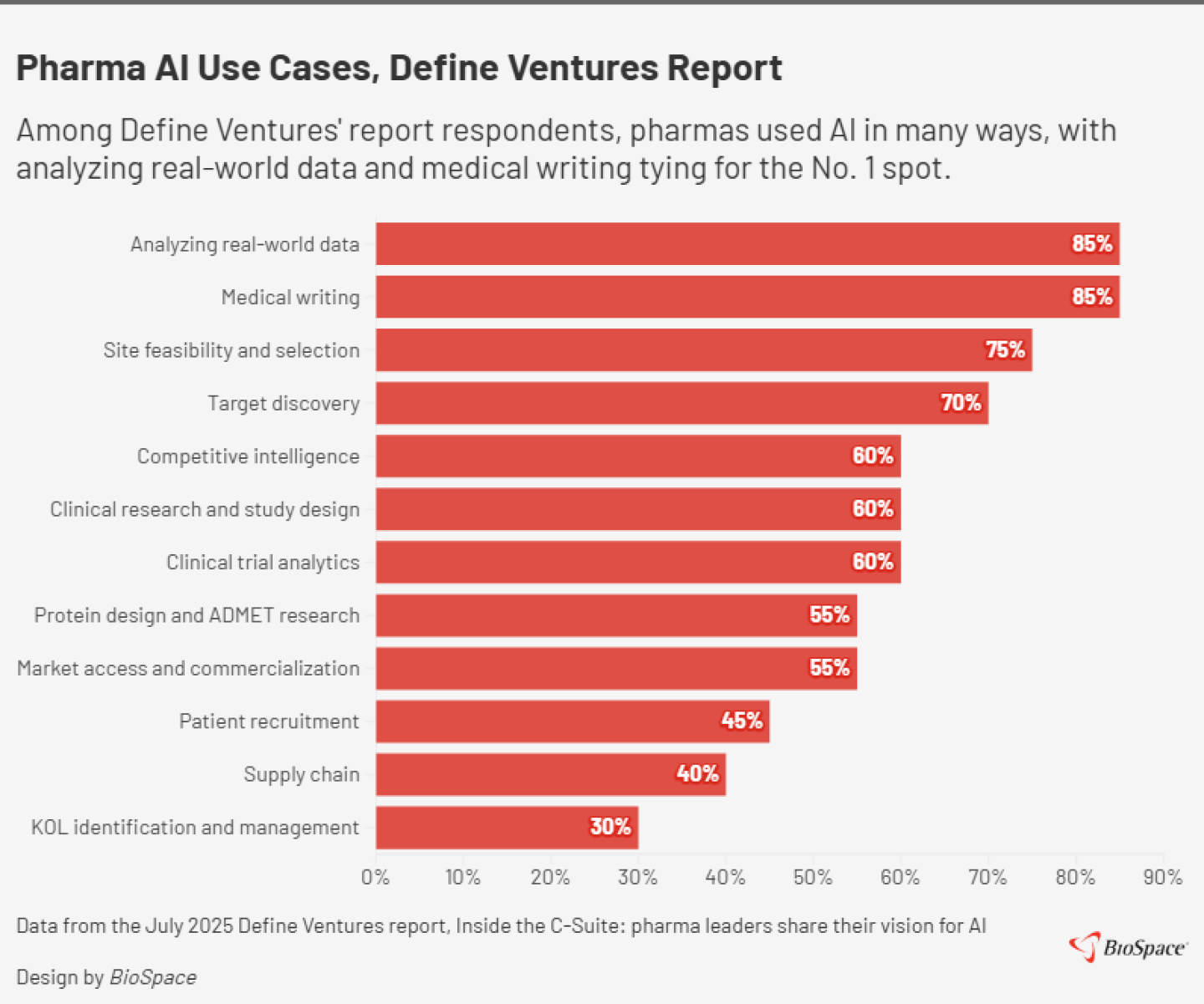A new report found that 85% of pharma respondents are increasing their artificial intelligence investments, and 70% see AI as an immediate priority. Two experts discuss how biopharmas are implementing and adopting AI, including their increased use of external help with the process.
Biopharma industry challenges and budget cuts don’t appear to be affecting artificial intelligence (AI) investment, implementation and adoption. For example, according to venture capital firm Define Ventures’ new report about AI deployment at pharmas, 40% of respondents are significantly increasing and 45% somewhat increasing their artificial intelligence investments even as overall budgets contract.
Chuka Esiobu, a principal at Define Ventures, told BioSpace that investment increases amidst regulatory headwinds and budget cuts point to companies’ need to streamline operations, drive more value and continue to be innovative.
Define Ventures also found that 70% of pharma leaders—and 85% among the top 20 pharmas—view AI as an immediate priority. Best-in-class players, the report noted, are embedding AI into core workflows, guided by strong C-suite sponsorship and cross-functional governance. As to how pharmas are using AI, Define Ventures found that 85% of respondents have leveraged it for analyzing real-world data, and the same percentage have used it for medical writing, making those the top two current use cases. Looking ahead, 94% are prioritizing medical writing for an AI use case in the next year.
ManpowerGroup, a global workforce solutions company, has also seen pharmas—and biotechs—embrace AI despite challenges, according to Greg Coir, head of vertical strategy for healthcare and life sciences at the firm. He told BioSpace that although some biopharmas have put capital expenditures on hold because of uncertainty, they’re not pausing AI investment, support and development.
“What we’re hearing is this is being prioritized,” Coir said.
He also provided insight into ManpowerGroup’s third quarter 2024 survey finding that AI adoption in healthcare and life sciences was the lowest of any industry vertical. The company reported that 38% of that sector’s employers globally are using AI tools such as ChatGPT, which is below the average adoption rate (48%) for all industries. Coir said the rate would have been higher for life sciences had it been separated out as its own vertical.
Additionally, he shared that based on what ManpowerGroup clients are saying and what the company is seeing in the life sciences industry, AI adoption rates among the industry’s businesses would be significantly higher now.
AI Helps Biopharmas Stay at the Front of the Line
Coir and Esiobu emphasized the need for biopharmas to adopt AI now, not later, given how it can help them stay competitive by improving speed to market. Esiobu, for example, noted that clinical data and patent length used to be core differentiators for many large pharma, but the Inflation Reduction Act and postmarket competition are starting to erode them. Now, he said, how quickly companies discover, develop and distribute drugs becomes just as much—if not more—of a differentiator going forward.
“Many of the pharmas, if you look at the pipelines of large pharma, are going after very similar targets, and so I think it’s a bit of a fool’s errand in today’s ecosystem to believe that doing business as usual will keep you in the front of the line,” Esiobu said.
Regarding biotechs specifically, he noted that businesses that have technical founders or technical blood are AI native from the start because they know artificial intelligence is their competitive edge.
Given that AI can help biopharmas compete by improving speed to market, and can also reduce costs, companies that haven’t implemented it yet need to act immediately, according to Coir.
“It’s just so important,” he said. “If they’re not adopting it, then they’re going to be way behind.”
Biopharmas Increasingly Seek Outside Help With AI
For companies deploying AI, using outside expertise with the process is gaining traction. For example, the Define Ventures report noted that although pharmas have traditionally built AI solutions in-house, 40% of pharma leaders expect to split efforts between internal development and external partnerships. Thirty percent are leaning toward external-first strategies.
“This shift reflects a growing recognition that internal teams alone may not be able to move fast enough or capture the full value AI offers,” the report noted.
External help also comes into play from a day-to-day workforce perspective. ManpowerGroup’s survey found that among healthcare and life sciences employers looking to accelerate AI adoption, employee skills gaps was a top challenge. For example, Coir said, in-demand roles that merge science, technology and AI, such as researchers who can perform data analysis, are where big skills gaps are located. One way companies address that, he noted, is by using consultants or having external talent upskill or train employees.
“We see many of our clients that are moving toward a model in which a certain percentage of their overall workforce is internal, and then another certain percentage is external in nature, moving toward a goal or objective from a balance perspective,” Coir said. “So, it does differ from organization to organization, but I would say every one of our large global pharma clients, it has to be a mix of both, a balance.”
Interested in more career insights? Subscribe to Career Insider to receive our quarterly life sciences job market reports, career advice and more.







